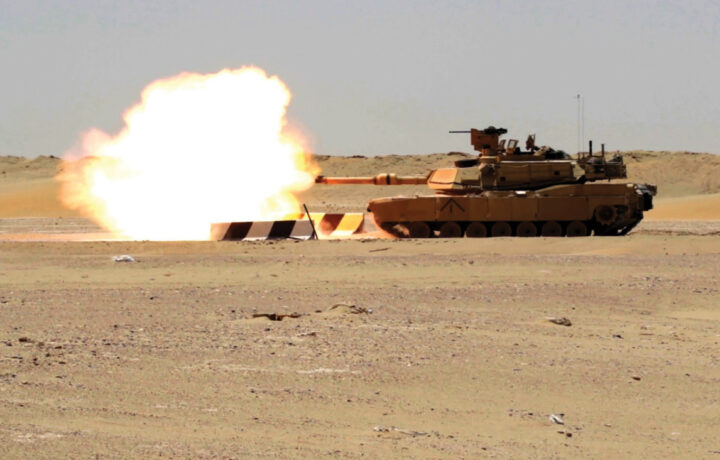Small, off-the-shelf commercial unmanned aerial vehicles (UAVs) have become a force multiplier in the ongoing conflict in Ukraine, where both sides have used them to target the enemy’s armored vehicles, notably main battle tanks (MBTs). Drones and loitering munitions have been even more effective than man-portable rocket-launched anti-tank weapons.
One factor is that today’s MBTs were developed with heavy front-facing and side armor. Against another tank, the vulnerability has been the undercarriage and the rear of the tank. Drones have proven to be a game-changer, as the aerial platforms can strike the top of a tank, where the armor is far lighter.
Although tanks have been outfitted with explosive reactive armor (ERA) to counter the rockets, there is only so much additional protection that can be added. In some cases, Russian and Ukrainian forces have responded by employing screens and “cope cages” among other ad hoc solutions. The idea here is to keep the drone from striking the vehicle.
New Anti-Drone Tactics
There will be no easy solution to countering drones, but the U.S. Army has published new instructions directing M1A2 Abrams crews on how to engage the aerial threat better. The “React to Unmanned Aircraft System While Mounted – Platoon” memorandum outlined the procedures that crews should follow when an unmanned aerial system is detected.
“Contact with unidentified UAS may be a precursor to an imminent attack. All units who were in the UAS’s path should assume they were observed and prepare for indirect fire on their positions,” the guidelines explained.
“The use of overhead protection on vehicles, such as netting or chain link sections, can mitigate the effects of direct attack by providing standoff from dropped munitions or self destructing sUAS,” it added, noting that sUAS are typically employed as an Intelligence, Surveillance, and Reconnaissance (ISR) platform. These eyes in the sky can act as an “observer for indirect fires, Electronic warfare (EW), and/or outfitted with various munitions and used as a direct attack platform.”
Platoons are directed to increase dispersion, while maintaining a safe distance between armored vehicles, and seeking cover or concealment when possible.
Taking Aim
If orders are given to continue a mission, tank and other vehicle crews are directed to secure all hatches, doors, and ramps. The guidelines provide instructions on how to counter drones.
“Low, Slow, Small Unmanned Aircraft Systems (LSS UAS) can fly extremely low underneath traditional radar detection zones. UAS fly very slow and can even hover in place preventing current sensors from detecting them. UAS are very difficult to defeat using direct fire weapons,” the guidelines noted.
However, despite the warning that UAS can be difficult to defeat with direct-fire weapons, the current doctrine still calls for employing these weapons. Key instructions are provided:
(1) Direct vehicles to aim based on type and course of UAS.
(2) Direct vehicles to engage with all machine guns or 120mm canister rounds.
(3) Direct cease fire when aircraft is destroyed or no longer a threat.
Using the M1028 Canister Round
The specific round to be used from the M1A2 Abrams’ 120mm main gun is the M1028 canister round, which was designed to disperse shrapnel over a vast area.
According to General Dynamics Ordnance and Tactical Systems (GD-OTS), the maker of the ordnance, the M1028 Canister Cartridge “was developed for close-in defense of tanks against massed assaulting infantry attack. The M1028 Canister Cartridge was designed to break up infantry concentrations, between a range of 200-500 meters, by discharging large numbers of tungsten balls from the main cannon.” It is like a large shotgun blast, or grapeshot used against infantry since the Revolutionary War.
Though the M1028 cartridge was designed as an anti-personnel round to counter assaulting infantry and “RPG ambushes,” its wide dispersal pattern could be highly effective against aerial threats.
The guidance calls for aiming at drones that are roughly “half a football field,” or approximately 50 yards (55 meters), while the blast should target the drone’s fuselage. This is an update to a similar doctrine for targeting low-flying aircraft and helicopters with the M830A1 multi-purpose round.




